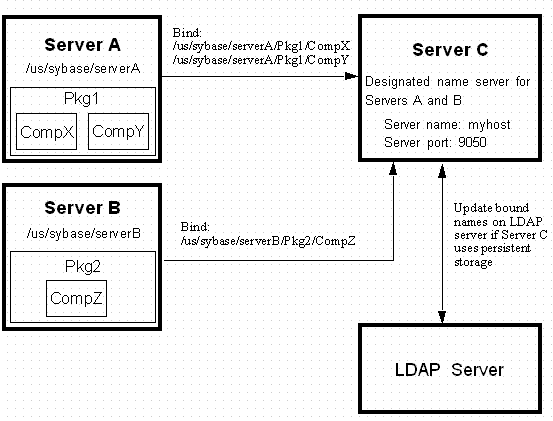

Chapter 2 Jaguar Naming Services
The process of binding objects is performed by a name server. Each Jaguar server can be its own name server, or you can configure a Jaguar server to use another server as its name server. You can also use an external naming service, such as an LDAP server, in conjunction with Jaguar's naming service.
You set the naming service options for each Jaguar server using the Naming Service tab on the Server Properties window.
The Jaguar naming service relies on an "initial" or default name context for each Jaguar server. You set the initial context when you set up the Jaguar Naming Service properties.
The server name context syntax follows a specific organization or schema. You can use this schema to represent the hierarchy of objects in the namespace, for example by geographic region, organizational unit, and so on.
If you use a Jaguar server as the name server, and do not use an external naming service, the initial context for your Jaguar server uses this format:
<Level 1>/<Level 2>/<Level 3>/...
The number of levels depends on the hierarchy you want to represent. For example:
US/sybase/finance
US/sybase/marketing
US/sybase/sales
If you use an LDAP server as an external naming service, the initial context must follow the syntax and schema of the LDAP server. LDAP servers have predefined schema for common objects such as country, organization, and organizational unit. Jaguar uses the following format for an LDAP-compatible initial context:
ou=<organizational unit>, o=<organization>, c=<country>
Using the previous examples, the initial contexts would be:
ou=finance,o=sybase,c=US
ou=marketing,o=sybase,c=US
ou=sales,o=sybase,c=US
On start-up, the name server binds all object implementations on a Jaguar server to the initial context of the server on which the object is installed. Once the server binds an object, the structure of the resulting name context is:
<initial context>/<package>/<component>
where
<initial context> is the initial context property for the server where the component is installed.
<package> is the name of the package being bound, as displayed in Jaguar Manager.
<component> is the name of the component being bound, as displayed in Jaguar Manager.
If you have multiple Jaguar servers that use one Jaguar server as their name server, the name server binds the objects on those servers using the initial contexts of their respective servers. If you do not specify an initial context for any of those servers, the name server binds the objects with the initial context of the designated name server.
![]() You can set the server properties to enable password
protection for name binding on a Jaguar name server. See "Name binding
password security".
You can set the server properties to enable password
protection for name binding on a Jaguar name server. See "Name binding
password security".
To illustrate how a Jaguar name server uses the initial context to create name contexts for objects on multiple servers, let's say you have three Jaguar servers:
When you start server A, it connects to server C, using the name server URL you entered in server A's Naming Service properties. The name server gets the initial context for server A and binds each object installed on server A. The resulting name contexts are based on server A's initial context, the package name, and the components in the package. For this example, the name server creates the following bindings:
/us/sybase/serverA/Pkg1/CompX
/us/sybase/serverA/Pkg1/CompY
If you are using an external naming service such as LDAP, the name server also updates the existing object references on that server, if any.
When you start server B, the name server creates the following binding:
/us/sybase/serverB/Pkg2/CompZ.
Figure 2-1 illustrates the name binding process.

An application referencing object CompY uses the URL of the name server, followed by the object's name context. For example:
iiop://myhost:9050/us/sybase/serverA/Pkg1/CompY
The name server finds the name context in the namespace, resolves the name context with the object it references, then implements the object.
If you had not assigned an initial context to Server A, the name server, server C, would create name contexts for objects Pkg1/CompX and Pkg1/CompY using the initial context of the name server. In this case, the client application can simply retrieve CompY using this URL:
iiop://myhost:9050/Pkg1/CompY
Jaguar's naming service inherently provides transient object name storage. The name server is instantiated when you start a Jaguar server, and binds names to all the known object references. The name server provides the bound name and object references to the Jaguar server's session manager object. Because this information is stored in memory, the name context information is retained only as long as the Jaguar server is running.
You can add persistent object name storage capabilities to Jaguar by using an external directory naming service, such as an LDAP server. The external server retains object name information, and the Jaguar name server updates this information whenever it creates new bindings or unbinds existing ones.
To use an external naming service, specify the URL of the external server in the Naming Service properties of the designated Jaguar name server. You must also provide a manager DN (distinguished name) and password that has exclusive access to all objects in the LDAP server database for Jaguar to be able to update the stored name context information.
| Copyright © 2000 Sybase, Inc. All rights reserved. |

| |